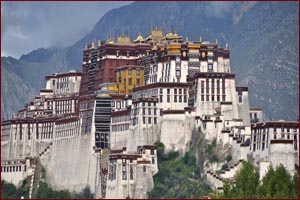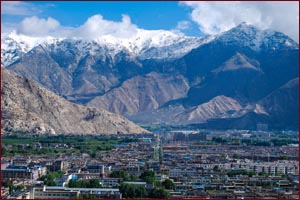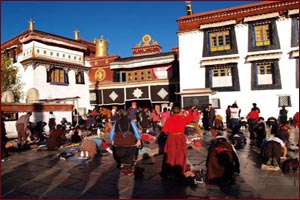3 nights 4 days Lhasa tour
Destination: – Lahasa
Day 01: Arrival Lhasa
 Today our representative (Guide) will receive you from Airport/Railway Station. Introducing himself and the driver and offering warm welcome with Khaada/Mala/White Scarf.Khaada is Tibetan traditional welcomming and blessing scarf which consist meaning of goodluck too. Lhasa Gongkar Airport is 70kms from the Lhasa city. Lhasa Train station is about 5kms from the city. From airport you will start you sightseeing. This sightseeing consists of Lhasa River and Yarlungzanpo River. Nevertheless your trasportation will not stop on any of this spot but you can ask the driver to stop for some few shot from your camera. Other scenic are mountains and the Nyetang Giant Buddha. We suggest clients to not to sport on first day and have complete rest for acclimatization.
Today our representative (Guide) will receive you from Airport/Railway Station. Introducing himself and the driver and offering warm welcome with Khaada/Mala/White Scarf.Khaada is Tibetan traditional welcomming and blessing scarf which consist meaning of goodluck too. Lhasa Gongkar Airport is 70kms from the Lhasa city. Lhasa Train station is about 5kms from the city. From airport you will start you sightseeing. This sightseeing consists of Lhasa River and Yarlungzanpo River. Nevertheless your trasportation will not stop on any of this spot but you can ask the driver to stop for some few shot from your camera. Other scenic are mountains and the Nyetang Giant Buddha. We suggest clients to not to sport on first day and have complete rest for acclimatization.
You will be dropped to the assigned hotel. Overnight in Hotel.
Day 02: Lhasa Sightseeing
Today at morning you will have your breakfast in the hotel. Guide will receive you on time in the hotel. Today you will do the sightseeing of Potala Palace, Jokhang Temple and Barkhor street.
Potala Palace: Scared Potala Palace is percehed upon the Ri Marpo (Red Hill) 130meters above above Lhasa valley. Potala Palace itself rises 170 meters further making it the highest monumental in Tibet. Marpo Ri has legends that its rocky hill is scared cave was dwelling place of Bodhisattva Chenresi (Avalokitesvara), later used as Meditation cave of Emperor SongtsenGampo. In 637 AD SongtsenGompo built a palace on this hill and this structure stood untill 17th century. The construction of present palace was built in the reign of The 5th Dalai Lama in 1645. PotrangKarpo and PotrangMarpo was completed on 1648.
Scared Potala Palace is percehed upon the Ri Marpo (Red Hill) 130meters above above Lhasa valley. Potala Palace itself rises 170 meters further making it the highest monumental in Tibet. Marpo Ri has legends that its rocky hill is scared cave was dwelling place of Bodhisattva Chenresi (Avalokitesvara), later used as Meditation cave of Emperor SongtsenGampo. In 637 AD SongtsenGompo built a palace on this hill and this structure stood untill 17th century. The construction of present palace was built in the reign of The 5th Dalai Lama in 1645. PotrangKarpo and PotrangMarpo was completed on 1648.
Jokhang Temple:
The Jokhang or Tsuklakang (gTsug lag khang), is located on Barkhor Square in Lhasa. It was built during the reign of King Songsten Gampo (605?-650 CE) to celebrate his marriage with Chinese Tang Dynastyprincess Wencheng, who was a Buddhist. During the Bon period of Tibet the temple was (and sometimes still is), called the 'Tsuklakang' (Tsulag Khang) — 'House of Religious Science' or 'House of Wisdom.' The term tsuklak refers to the 'sciences' such as geomancy, astrology, and divination which formed part of the pre-Buddhist shamanistic religion now referred to as Bon.[2] It is more commonly known today as the Jokhang, which means the 'House of the Buddha'.For most Tibetans it is the most sacred and important temple in Tibet. It is in some regards pan-sectarian, but is presently controlled by the Gelug School. Along with the Potala Palace, it is probably the most popular tourist attraction in Lhasa. It is part of the UNESCOWorld Heritage Site "Historic Ensemble of the Potala Palace," and a spiritual centre of Lhasa.
Barkhor Street:
Barkor Street, which has a history of over 1,000 years, surrounds the Jokhang Temple. It was originally an important route for Tibetan Buddhists to walk clockwise around to show their devotion. This religious behavior is called 'Barkor' in Tibetan Language. As one of the most bustling sections in Lhasa nowadays, Barkor Street features in sale of various kinds of handicrafts and living necessities from local areas, India and Nepal. In addition, it has also become one of the tourism attractions for visitors from at home and abroad because of its unique historical, cultural, religious, ethnic and commercial characteristics. Everyday, a large number of pilgrims walk clockwise around while turning their prayer wheels, lamas roam around, backpackers pass by, and tourists enjoy a moment of tranquility in bars around Barkor Street.
Day 03: Lhasa Sightseeing  Today after breakfast you will do the sightseeing of Drepung Monastery, Sera Monastery.
Today after breakfast you will do the sightseeing of Drepung Monastery, Sera Monastery.
Drepung Monastery:
It was founded in 1416 by Jamyang Choge Tashi Palden (1397-1449), one of Tsongkhapa's main disciples, and it was named after the sacred abode in South India of Shridhanyakataka. Drepang was the principal seat of the Gelugpa school until the Great Fifth Dalai Lama constructed the Potala and it retained the premier place amongst the four great Gelugpa monasteries. Drepung was known for the high standards of its academic study, and was called the Nalanda of Tibet, a reference to the great Buddhist monastic university of India. In the late 1930s Drepung was divided into four colleges, each housing monks from a different locality: "one being favoured by Khampas, another by Mongolians, and so on." Each college was presided over by an abbot who had been appointed by the late 13th Dalai Lama.
Sera Monastery:
Sera was founded in 1419, by JamchenChojey (Sakya Yeshe), a disciple of TsongKhapa.Like the Drepung and Ganden monasteries, it had several colleges: Sera MeyDratsang, built in 1419, gave basic instruction to the monks. Sera JeyDratsang, built in 1435, was the largest, and was reserved for wandering monks, especially Mongol monks. NgagpaDratsang, built in 1559, was a school for the teaching of the Gelukpatantras. Sera housed more than 5,000 monks in 1959. Although badly damaged following the invasion of Tibet and the Cultural Revolution, it is still standing and has been largely repaired. In 2008, it housed 550 Buddhist monks, but the number dropped till date.
Norbulinka Monastery:
The park was begun by the 7th Dalai Lama beginning in 1755. The Norbulingka Park and Summer Palace were completed in 1783 under Jampel Gyatso, the Eight Dalai Lama, on the outskirts of Lhasa.[1] and became the summer residence during the reign of the Eighth Dalai Lama.The stables of the Dalai Lamas in Norbulingka, photographed in 1986.The earliest building is the Kelsang Potang Palace built by the Seventh Dalai Lama which is "a beautiful example of Yellow Hat architecture. Its fully restored throne room is also of interest." The 'New Palace' was begun in 1954 by the present Dalai Lama and completed in 1956. It contains chapels, gardens, fountains and pools. The gardens are a favourite picnic spot and provides a beautiful venue for theatre, dancing and festivals, particularly the Sho Dun or 'Yoghurt Festival', at the beginning of August, with families camping in the grounds for days surrounded by colourful makeshift windbreaks of rugs and scarves and enjoying the height of summer weather.The palace is located three kilometers west of the Potala Palace which was the winter palace. Additional buildings were added to the park during the first half of the 20th century. There is also a zoo at Norbulingka, originally to keep the animals which were given to the Dalai Lama.
Day04: Drive to Gongkar Airport/Railway Station and fly toBeijing/Shanghai/Chengdu/Xi'An/Xining/Kathmandu.
